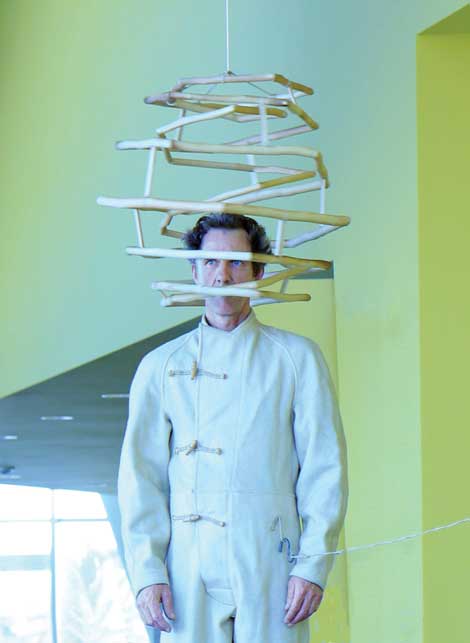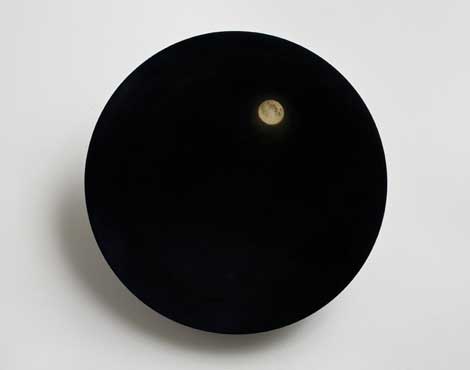Ross Rudel’s art has haunted my consciousness for a few years now. Encountering occasional works of his in group shows throughout Los Angeles, I would find myself consistently drawn in and hypnotized by what felt like a quiet, faraway presence filled with hidden potency. The LA–based artist’s sculptures and performances, carefully crafted and often employing found objects, exude deep mystery and deep purpose. Why does this work—sometimes so slight and minimal as to be barely noticeable in the gallery—have so much resonance? Where does this strange energy come from?
Curators like to include Rudel in exhibitions that have a mystical or occult theme. My most memorable encounter came in the form of a group show called “Sanctified: Spirituality in Contemporary Art” (2013), curated by Mary Anna Pomonis for the Vincent Price Art Museum. It featured two pieces by Rudel: Harvest Moon (2010), a wooden disc coated with resin and India ink, toward the edge of which is embedded a small, shining full moon, and Solicitation (2013), a large wooden pedestal coated with graphite on top of which sits a small animal shell with a long crow’s foot claw protruding out of one end.
Both works seem to reach back to the very roots of our prehistoric existence as a species. The inky depths and piercing lunar light of Harvest Moon transport the viewer’s gaze to the far reaches of the visible cosmos, evoking our deepest desires to seek and to know. The slightly terrifying Solicitation presents for our contemplation an animal remnant that looks both familiar and alien. Crustacean in form, it could have been excavated from the most ancient of river beds, or it could have been a living beetle taken from the contemporary wilds of Africa. Intriguingly, the end opposite the claw is hollow and, according to the text that accompanied it, designed to perfectly fit the artist’s index finger.
“A lot goes into the creation of each artwork,” Rudel says to me during a recent studio visit. “The finished work represents some sort of culmination or cumulative point of everything that has happened before, from conception to resolution. I believe that a work can be imbued with potency this way, through my attention; if I care about it enough, it will come across to the viewer.”
The piece that he is most interested in talking about on this day is Nebulizer, a performance he has given twice, most recently at the “Perform Chinatown 2014” event. From a single scavenged strand of ash wood, Rudel crafted a small, helmet-sized dome that, when spun, circled up and down on itself like a circular, two-layered Möbius strip. For the performance, Rudel hung the dome and wound it so that when released, it spun for a good few minutes. He then stood on a small pedestal, elevating himself just a bit from the ground, and placed his head inside the dome while it unwound. He gazed forward impassively as the wooden strands undulated around his hair, making it stand on end.
Over the course of our discussion, I realize that infinity, circles and feedback loops are a recurring motif in Rudel’s practice, along with dreams and an esoteric interest in solving formal problems. Several years ago, he had a vivid dream that he was in the home of a wealthy collector and saw a spectacular mandala on the wall made entirely of playing cards. In the dream, he became obsessed with plagiarizing this work of art; in real life, he spent the next year figuring out how to make a mandala out of playing cards in such a way that the composition would be resolved. After much trial and error, he produced Proprietary Dream Mandala (2008), in which 169 cards (13 spokes with 13 cards in each spoke) fan out from the center and are lined up in numerical order. These particular playing cards were “retired” from the Silverado Casino in the historic gold mining town of Deadwood, South Dakota, and thus carry the residual energy of those who gambled on them.
But perhaps most essential to Rudel’s practice are the mysterious and eternal workings of the natural world. As a teenager, the artist lived in South Dakota and became enamored of exploring the Black Hills and their extensive network of caves. “When you’re deep in the recesses of the planet, everything looks biomorphic, there’s crystal everywhere—it’s a magical place,” he enthuses. Today, Rudel continues to seek out the magic that comes from intense communing with nature. He is fond of “trying to get lost” in Joshua Tree, and often goes for midnight runs in Griffith Park with no clothes on, having close encounters with animals along the way.
Rudel’s proclivity for meditative, solitary acts have made him highly observant of the natural cycles and connections that occur as part of life on this planet. Rather than espousing any specific set of spiritual or mystical beliefs, he is more prone to seeing the enchantment and the ecstasy inherent in the everyday. “I’ll believe anything, if it will get me somewhere interesting!” he laughs. “Once every few years or so, I’ll make a work that I think is a masterpiece, and it will feel like hitting the period at the end of a sentence. But then I’ll just keep looking for the next thing. I’m never satisfied.”






